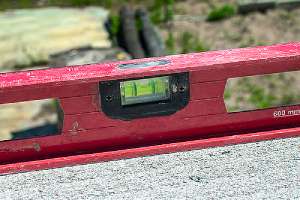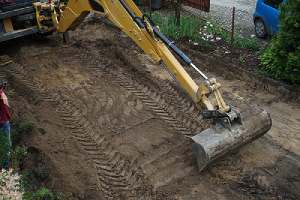 Land grading is the process of creating a specific gradient in the land. This can include giving a specific slope to it or leveling it so that it is flat. Usually, the process begins by removing the top layer of soil from the area being graded, and then adding new material, either fill dirt or a layer of gravel, and grading out to be level or have the slope you want.
Land grading is the process of creating a specific gradient in the land. This can include giving a specific slope to it or leveling it so that it is flat. Usually, the process begins by removing the top layer of soil from the area being graded, and then adding new material, either fill dirt or a layer of gravel, and grading out to be level or have the slope you want.
For yards, the process is simpler. Find the lowest point in the yard, and use fill dirt to raise it up to be the highest point.
Why Your Yard Needs To Be Graded
Simply put, grading helps resolve drainage issues in your yard. If you see stagnant pools of water in your yard, then you know you have a drainage problem. Those pools are not just ugly, either, they are a perfect breeding ground for mosquitoes.
They can also drown the grass in that area, leaving unsightly brown patches behind when the water finally drains or evaporates. All that water sitting in your yard can even cause foundation problems for the house, because if the water is not draining, it is being soaked up by the soil, which causes it to expand. This pushes your home up and applies pressure to the foundation.
You may even have water leaking into your home because of a drainage problem, especially if the yard slopes toward the house. Yard grading will solve these drainage problems and allow you to control the direction that the water runs off in.
How To Grade A Yard
The actual work of grading the yard is not especially difficult, but it does require some planning to make sure that it is done right and does not cause other problems for you in the future.
Check Pipes, Vents, And Traps
 Grading your yard properly means that the yard will slope away from the house. Doing this means that the ground level at the wall will be higher than it is now. Your home will have pipes, vents and traps around the outside, usually not too far off from ground level.
Grading your yard properly means that the yard will slope away from the house. Doing this means that the ground level at the wall will be higher than it is now. Your home will have pipes, vents and traps around the outside, usually not too far off from ground level.
If something like that is above ground level now, it needs to stay above ground level. Vents obviously have to, but it may be tempting to not worry about pipes as much. Do not make that mistake. If it is above ground level, there is a reason for it.
This may require you or a professional to do some work in advance to extend or relocate anything that might be too low.
Buy Window Wells
If you have a basement, and that basement has windows, the best thing to do is buy a window well. This will allow you to grade the yard as it needs to be graded without covering up the window or requiring you to move the window, assuming that would even be possible.
Determine How Much Space You Need
Grading your yard means that the ground right at the external wall of your home will be the highest point in the yard. As a way to gauge this, you need a minimum of 6 inches of foundation showing above the dirt at the end of the process to avoid structural damage. This is actually part of the building code, and your local building code may require even more clearance.
You may not be able to raise the soil high enough at the side of the house to be higher than the highest point in your yard. If that is the case, grading is not a good idea. French drains could be an excellent alternative solution for you.
Find the high and low points
Grab a can of spray paint to mark them. The high points are where the water starts to drain in the wrong direction, i.e. towards the house. Low points are where the water pools and stagnates.
Establish a grade line
You will need wooden stakes and rope for this. You are establishing the run- the horizontal distance of the grade- and the rise- the vertical distance. Put one stake at the highest point and another at the lowest. Attach a string between them and make sure it is perfectly level.
To find the rise, simply measure the distance between the string and the ground at the lowest point.
Buy Dirt
Make sure you get quality fill dirt; the better the dirt, the better the drainage will be. Do not buy the cheapest stuff you can find at the hardware or gardening store. Order fill dirt from a reputable company. They will deliver it to you and you will know that you have quality soil that drains well.
Dump The Dirt
Put all of the dirt on the lowest point of the yard. For most people grading their yards, this will be right next to the foundation. You need enough dirt for this spot to be higher than the rise you just measured, which is why that measurement is so important.
Spread The Dirt
 Use the back of a rake or something similar to smoothly spread the dirt from old low point to the old high point. What you are doing is switching them- the old low point is the new high point, and the old high point is the new low point.
Use the back of a rake or something similar to smoothly spread the dirt from old low point to the old high point. What you are doing is switching them- the old low point is the new high point, and the old high point is the new low point.
Tamp It Down
You need to pack down the dirt as you go so that you know you have enough. Otherwise the dirt will slowly settle on its own, and you will find that you create a steep enough grade. You can buy a tamper or use sheets of plywood and stomp on them to pack the dirt down.
Plant New Grass
Spread grass seed over the bare dirt and water it.
As you can see, this is not a terribly difficult project. The most important thing you can do is be sure to use quality fill dirt so that it will continue to drain properly for a long time. If you would like more information about land grading, or would like to schedule a delivery of fill dirt to grade your yard, contact Dirt Connections today.










































